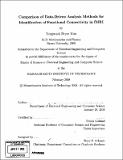| dc.contributor.advisor | Polina Golland. | en_US |
| dc.contributor.author | Kim, Yongwook Bryce | en_US |
| dc.contributor.other | Massachusetts Institute of Technology. Dept. of Electrical Engineering and Computer Science. | en_US |
| dc.date.accessioned | 2008-11-07T18:54:45Z | |
| dc.date.available | 2008-11-07T18:54:45Z | |
| dc.date.copyright | 2008 | en_US |
| dc.date.issued | 2008 | en_US |
| dc.identifier.uri | http://hdl.handle.net/1721.1/43036 | |
| dc.description | Thesis (S.M.)--Massachusetts Institute of Technology, Dept. of Electrical Engineering and Computer Science, 2008. | en_US |
| dc.description | Includes bibliographical references (p. 97-103). | en_US |
| dc.description.abstract | Data-driven analysis methods, such as independent component analysis (ICA) and clustering, have found a fruitful application in the analysis of functional magnetic resonance imaging (fMRI) data for identifying functionally connected brain networks. Unlike the traditional regression-based hypothesis-driven analysis methods, the principal advantage of data-driven methods is their applicability to experimental paradigms in the absence of a priori model of brain activity. Although ICA and clustering rely on very different assumptions on the underlying distributions, they produce surprisingly similar results for signals with large variation. The main goal of this thesis is to understand the factors that contribute to the differences in the identification of functional connectivity based on ICA and a more general version of clustering, Gaussian mixture model (GMM), and their relations. We provide a detailed empirical comparison of ICA and clustering based on GMM. We introduce a component-wise matching and comparison scheme of resulting ICA and GMM components based on their correlations. We apply this scheme to the synthetic fMRI data and investigate the influence of noise and length of time course on the performance of ICA and GMM, comparing with ground truth and with each other. For the real fMRI data, we propose a method of choosing a threshold to determine which of resulting components are meaningful to compare using the cumulative distribution function of their empirical correlations. In addition, we present an alternate method to model selection for selecting the optimal total number of components for ICA and GMM using the task-related and contrast functions. For extracting task-related components, we find that GMM outperforms ICA when the total number of components are less then ten and the performance between ICA and GMM is almost identical for larger numbers of the total components. Furthermore, we observe that about a third of the components of each model are meaningful to be compared to the components of the other. | en_US |
| dc.description.statementofresponsibility | by Yongwook Bryce Kim. | en_US |
| dc.format.extent | 103 p. | en_US |
| dc.language.iso | eng | en_US |
| dc.publisher | Massachusetts Institute of Technology | en_US |
| dc.rights | M.I.T. theses are protected by
copyright. They may be viewed from this source for any purpose, but
reproduction or distribution in any format is prohibited without written
permission. See provided URL for inquiries about permission. | en_US |
| dc.rights.uri | http://dspace.mit.edu/handle/1721.1/7582 | en_US |
| dc.subject | Electrical Engineering and Computer Science. | en_US |
| dc.title | Comparison of data-driven analysis methods for identification of functional connectivity in fMRI | en_US |
| dc.type | Thesis | en_US |
| dc.description.degree | S.M. | en_US |
| dc.contributor.department | Massachusetts Institute of Technology. Department of Electrical Engineering and Computer Science | |
| dc.identifier.oclc | 243609280 | en_US |
